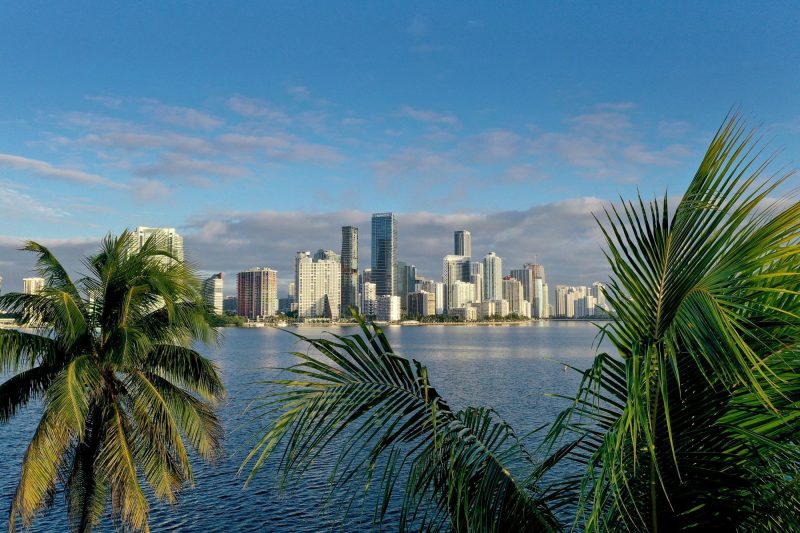Adapted from “The Aftermath” by Philip Bump, to be published Jan. 24 by Viking, an imprint of Penguin Publishing Group, a division of Penguin Random House. Copyright © 2023 by Philip Bump.
Republican Bob Martinez’s gubernatorial inauguration in Tallahassee on Jan. 6, 1987, was, happily, marked not by the violence that would erupt in D.C. 34 years later but by more mundane political impulses, like celebration and backbiting. Oh, and by furs.
“I saw a lot of dead animals hanging on people’s arms and necks that I don’t normally see in Democratic crowds,” a (Democratic) county commissioner from farther south in the state sniffed. I hesitate to use that hackneyed verb here, but it’s hard not to read that sentence without a near-audible sense of the disdain being offered. Sure, the dyed mink cowboy hat recorded by reporters was probably a bit over the top. But the observer’s annoyance was also likely colored by the change in power that the person under the hat was there to celebrate: Martinez’s win meant the governor’s mansion would be controlled by a Republican for the first time in 15 years and only the second time since Reconstruction. “The time when Democrats ruled Tallahassee unchallenged are clearly gone,” the South Florida Sun Sentinel’s report on the inauguration began.
A new day was dawning in another sense as well. Martinez was a native of Tampa, son of a restaurant worker and a seamstress. (Or so the campaign patter had it; Ida Martinez was also a supervisor at an athletic gear company.) In addition to being one of the only Republican governors in the state’s modern history at that point, he was also its first (and, of writing, still only) Hispanic chief executive. “¡Ole!” a headline in the English-language Orlando Sentinel welcomed him, in its way — “El tiempo de Martinez es aqui, you all.”
He took office at a remarkable moment. Florida was one of the fastest-growing states in the country, as he noted during his inaugural address. “Just last week, Florida became the fifth most populous state in the nation,” he said, having passed Illinois. “Before the year’s out,” he continued, “we will move into fourth place, passing Pennsylvania.”
Martinez mentioned this shift in status not to brag (or, not only to brag) but because of the implications it carried for the state and its government. “Eight hundred ninety-five new Floridians are arriving each day,” Martinez said. “Each day, we need another 130,000 gallons of water. Each day, there’s another 111,000 gallons of waste water and 4,200 more pounds of solid waste to dispose of, and each day we need two more miles of highway, three more jailbirds, two more police officers, two more classrooms and two more teachers to teach in those classrooms.”
The state was undergoing a population boom. That litany of exponentially increasing demands probably sounds familiar — a bit like the assessment of those tasked with accommodating the nation’s ballooning population of infants a quarter century prior. More everything, and now.
“We are a growing, vibrant state on the cutting edge of national leadership,” Martinez said at another point. This, clearly, was true, and Martinez — himself a descendant of immigrants from Spain — pointed to that population gain as the cause. “Our potential and our opportunities increase with the arrival of every new Floridian.”
Martinez didn’t get much of a chance to help bolster the state’s fortunes. Four years later, he lost reelection handily, battered by low voter approval for various initiatives he undertook, including an effort to restrict access to abortion in the state and a faltering national economy that pushed up unemployment rates. Then there were the intangibles. For example, there probably aren’t many governors who are referenced in songs from popular artists, but in July 1990, a few months before the election, Martinez became one. Angered at his efforts to ban their music, the hip-hop act 2 Live Crew recorded and released the track “F— Martinez.” A few months later, he was replaced by Democrat Lawton Chiles, and a different set of befurred celebrants came to the capital.
On Jan. 6, 1987, Martinez’s arrival represented multiple shifts in Florida’s trajectory. No state serves as a better encapsulation of the baby boom generation. From the opening of Walt Disney World in Orlando in 1971, offering an East Coast destination for the boom’s younger members, to the Potemkin Americana of The Villages housing development, the state has been a mecca. That population boom occurring at the time of Martinez’s election? Disproportionately a function of the arrival of baby boomers. In 1990, 4.9 percent of baby boomers lived in Florida. By 2020, more than 7 percent did, the biggest increase of any state.
If the United States’ demographic, political and economic changes progress as we might by now expect, what results likely won’t look much like Vermont (heavily White, largely rural) or, say, Alaska. What it might look like, instead, is Florida.
As I was exploring America’s political future, I called consultant David Johnson, an old hand in Florida politics though his Tennessee accent betrays his roots. Politics pushed him to the Sunshine State with the Bush-Quayle election of 1988, and he’s been there ever since.
Johnson was quick to point out that I might take his predictions with a grain of salt. After all, he had on the post-2012 assessment of how the Republican Party might move forward, an assessment that put an emphasis on reaching out to non-White voters in recognition of how the country was evolving. “And then Trump came and blew the whole thing apart in terms of, well, here’s what you should do,” Johnson said. Trump took a slightly modified approach: “Well, let’s do exactly the opposite.”
But, then, it also wasn’t the case that increased diversity inexorably led to a decline in Republican fortunes, as passing elections in Florida itself made clear. “What’s fascinating in Florida are the demographic changes, and what we think we’re going to see happen, oftentimes we don’t,” Johnson said. “We absolutely don’t.” The pool of registered voters in Florida has become significantly less White in the last few years, he noted — yet the state remains tightly competitive at both the national and state level.
In part, that’s because the population continues to expand with the arrival of more retirees — often older Whites who vote regularly. In 2019, about 1,600 people a day moved to the state on net. “The boomer generation is moving into fuller retirement age now — we’re seeing it — there’s been a lot of money invested here in Florida in different areas trying to build retirement communities, much like The Villages or those type of model,” Johnson said. “These are vast tracts of land, but they’re in areas in the past where the Democrats have done well, like Volusia County.”
Volusia County is home to Daytona Beach, just northeast of Orlando. In 2008, Barack Obama won it by about six points, slightly better than his national margin. In 2020, after an influx of older Republicans, Trump won it by 14 — 18 points better than his national performance. “It doesn’t take much of a change in what’s swimming in the swimming pool to really change the Florida landscape,” Johnson said, offering a state-appropriate analogy.
Yet not all such changes necessarily affect the overall political landscape. Johnson’s expectation in 2013 had been that the percentage of Whites in the electorate would drop a point or two in each cycle, Johnson said. But: “That has not been the case. That has not been the case at all.” In part, that’s because the number of Hispanics who vote has not grown at the same pace as the Hispanic population itself. In part, this is a function of citizenship; a fifth of the state’s Hispanics weren’t citizens in 2019. We can expect a similar disparity nationally.
Florida may offer a look at the future for another reason, as Johnson noted: climate change. A report from McKinsey released in April 2020 estimated that by 2030, tidal flooding due to higher sea levels would reduce the value of real estate in the state by 5 to 15 percent. By 2050, the decline was estimated at 15 to 35 percent — a total of $30 to $80 billion in lost real estate value. Not to mention more esoteric problems, like whether people can actually continue to live in places near the coast. “In ten years, if Miami Beach is not habitable, that’s going to be a big deal,” Johnson said, understating things a bit.
With its balance of disparate regions, from the deeply conservative Panhandle — essentially an extension of the Deep South — to the urban, Democratic region around Miami, the state includes an unusual geographic diversity. But there is a key way in which it’s an outlier, one that certainly affects its politics and is obviously pertinent to this discussion: It is old.
Since older voters skew more Republican and more White, that suggests an influence on state politics that other places won’t share. Though, of course, the America of the future will be similarly older and those older Americans still more densely White than younger generations. So is Florida an aberration, or is it a preview?
Johnson had some advice on this sort of speculation. “If we’d gone back 40 years ago, if we go back to 1980 when I was a kid,” he said — “in 1980, you could not dream of the internet economy. You could not fathom it. So what are we not fathoming that could happen within 10 to 15 years from now?”
In December 2019, we could not fathom what December 2020 would look like, much less December 2060. A useful reminder of our own shortsightedness. And one I’ll immediately ask that you set aside.
When considering where the country may be headed, let’s again fall back on what we can to some extent measure. We know what demographers expect the country to look like in 40 years’ time, and we know what the states look like now. Figuring that the most salient characteristics of the population for comparison to the future were race and age, I took Census Bureau estimates for the demographics of each state and compared them to the projected 2060 figures for the United States overall. If we compare the density of racial groups for those under 18 and those aged 65 and up in each state with those projections, there’s a wide spread of how closely current demographics map where the country is going. West Virginia, heavily White and old, doesn’t overlap with the future United States much at all. Nevada, more heavily Hispanic, aligns more closely.
The state that looks most like what we’d expect the United States to look like in 2060? Florida.
Where Florida’s current population deviates the most from the America of the future is that, once again, it is older. That’s even by the standard of the United States in 2060, where the percentage of the population that’s 65 and over will constitute 23 percent of the population, compared with about 17 percent in 2020. Florida’s population now also has a lower density of Asian Americans than expected for the country in four decades.
This is a rough presentation of a rough calculus. If we look at the 10 states that land closest to the 2060 U.S. population on each of the eight measured values, you can see that Florida aligns more closely on some (percentage of Hispanic residents under 18) and deviates on others (older Whites).
The states that most closely reflect the projected demography of the United States in 40 years are mostly ones that supported Joe Biden in 2020. Those 10 states voted for Biden over Trump by a 4.6 million-vote margin, 9.2 percentage points overall. They also constitute 30 percent of the population. The 10 states that least reflect that projected demography of the country in 2060 preferred Trump by 231,000 votes, a 2.9-point margin over Biden. Less than 5 percent of the population lives in those states. To put a fine point on it, the states that look most like how the United States is expected to look in the future are ones that right now vote more heavily Democratic. The ones that look least like that projection are ones that vote more heavily Republican.
This analysis is an attempt to construct one jigsaw puzzle out of 200 different boxes of pieces. Of course the country will look something as it does now, in the same way that the country looks now the way it did in 1980 to at least some degree. Were I to tell someone in 1980 that a relatively unknown real estate developer from New York City had been president, they’d likely have been rather surprised, but if I told them that an ambitious young senator from Delaware named Joe Biden was, that might be less jarring.
One way in which 2060 will look something like now: There will still be baby boomers, nearly 2.5 million of them per the Census Bureau’s pre-pandemic projections. Strom Thurmond was a senator until he was 100 years old; there will be nearly 2 million baby boomers younger than that in 2060, still eligible to serve. Biden was inaugurated the year he turned 79, a reminder that the youngest boomers could be inaugurated in 2043 without surpassing Biden’s record as oldest president upon taking office.
By then, there may also be other options.
“I remember somebody asking on social media who will be the first millennial president,” Marquette University’s Julia Azari told me, “and I was like, baby boomers are just going to holographically project themselves until the end of time” — a joke that is not as wild as you might expect.
During his inaugural speech in 1987, Martinez celebrated Florida’s growth and dynamism — but also identified the ways in which Florida’s success could be hampered.
“Floridians, whether native or new, are a unique blend of ethnic, racial and age groups. This diversity has produced a spirit of independence and enterprise — a can-do attitude — that is our greatest resource,” Martinez said. He’d said that the state’s potential increased with every new migrant to the state, but then warned of a reversal of that trend. “The day they stop coming is the day we will find it more and more difficult to maintain the quality of life that has made Florida synonymous with the good life,” he said.
It has consistently been migration, both domestic and international, that has spurred Florida’s population growth. While more Floridians were being born each year than died when Martinez was governor, it was migration that was pushing population total up so quickly. (From 1985 to 1990, there were about 5.5 new migrants to Florida from elsewhere in the United States for every immigrant from another country.) Since then, however, natural population change (that is, the number of births each year minus the number of deaths) has gone negative, a trend exacerbated by the coronavirus pandemic but one that was otherwise projected by state data. The state’s overall population growth is now solely a function of migration. The recent period when population growth was the smallest was when migration was lowest, during the recession that began in 2007.
So what happens if significant parts of Florida become uninhabitable (or even simply less habitable) due to climate change? What happens if changes in the state reduce the motivation for Americans or immigrants to move there? What if the federal government further constrains international migration?
Florida’s future is dependent on decisions made in the present. What happens between now and 2060 depends on the choices we make and the policies we implement. The long term depends on the short term.








